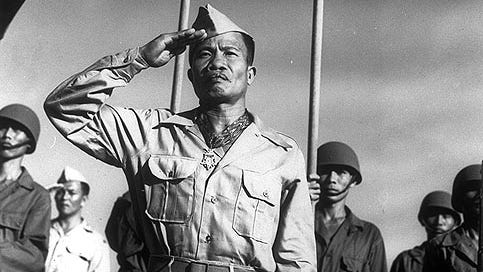Medal of Honor Monday: Jose Calugas
Who would have known that a mess sergeant on kitchen patrol duty would earn a Medal? Heroes come in all shapes and sizes, don’t they?
On this day in 1942, a hero engages in an action that would earn him the Medal of Honor. Jose Calugas served in the Philippine Scouts of the United States Army during World War II. He received the Medal of Honor for his actions during the intense Battle of Bataan.
Who would have known that a mess sergeant on kitchen patrol duty would earn a Medal? Heroes come in all shapes and sizes, don’t they?
The Battle of Bataan was fought almost immediately after the Japanese attack on Pearl Harbor. The Japanese had invaded the Philippines, working to seize more and more land in the Pacific. The Philippine Scouts were immediately called into action.
“There was no provision for all the troops in the Philippines,” Calugas’s son later reported of this time. “No air power, no food, no medical supplies, no ammo . . . .” The situation was perhaps unsurprising, given that the United States had just been sucked unexpectedly into a war that it was trying to avoid.
Calugas was among those serving at Bataan during January 1942. He’d been directing meal preparations when Japanese artillery fire began coming in to the area. Calugas soon noticed that a nearby gun position had been silenced, its crew wounded or killed. He swung into action, voluntarily sprinting more than half a mile toward that gun position.
It was no easy run. He was in constant danger from incoming artillery fire. But he was needed. And he went.
Calugas organized volunteers and got the gun back up and running again. He held the position for several hours, maintaining a much-needed line of defense. Calugas was recommended for the Medal and might have received it but for intervening events.
In April 1942, United States forces finally surrendered. Calugas hurriedly buried information about his Medal so that the Japanese would not realize that they had a potential recipient in custody. He was taken prisoner.
What followed was horrific. Exact figures remain unknown, but as many as 80,000 Filipinos and Americans were forcibly marched about 60 miles to a distant enemy camp. As many as 18,000 died during the so-called “Bataan Death March,” due to the barbaric and inhumane treatment that they received along the way. For Calugas, the months that followed as a POW were just as bad: Beatings, starvation, and disease were normal. After nine months, Calugas was released to work for a Japanese rice mill.
You don’t think that Calugas calmly went to work for the enemy, do you? He didn’t. Instead, Calugas surreptitiously helped Philippine guerrillas. When United States troops returned to free the Philippines, he was quick to jump in and fight. He finally received his Medal in 1945.
Calugas continued to serve in the Army after the war, reaching the rank of Captain. But his story ends with an odd twist: He’d been born in the Philippines, which was then a U.S. territory. He was an Army officer and a Medal recipient—but he was not a U.S. citizen. Since the war, the Philippines had been granted independence, which meant that Calugas now needed to apply for citizenship.
Obviously, he had no trouble with his application. :)
A few years ago, Calugas’s son spoke to a reporter, relaying his dad’s feelings about the Medal: “You know this Medal of Honor really belongs to the people, and he said, I’m the only wearer of the Medal. I wear it. But it really belongs to the people that died in the Philippines, the Filipino Scouts, and it belongs to all the public . . . .”
Bravery, selflessness—and humility. Common characteristics of Medal recipients, aren’t they?
Sources can always be found on my website, here.





Yes, it seems a common thread among MOH Awardees. The recipient is wearing the Medal for the others and his own actions were only singled out to wear the Medal. Sgt. Calugas wore his Medal proudly and deservedly.
Men like Mr. Jose Calugas are the true American Heros. Thank you Tara.
This time frame in the Philippines saw the last mounted cavalry charge of the US Army! The US 26th Cavalry charged a Japanese encampment, not with sabers but with 1911 Colt semi-automatic pistols! The unit then retreated into the mountains alone with many of the Philippine Scouts. Their story is pretty impressive but hard to read...